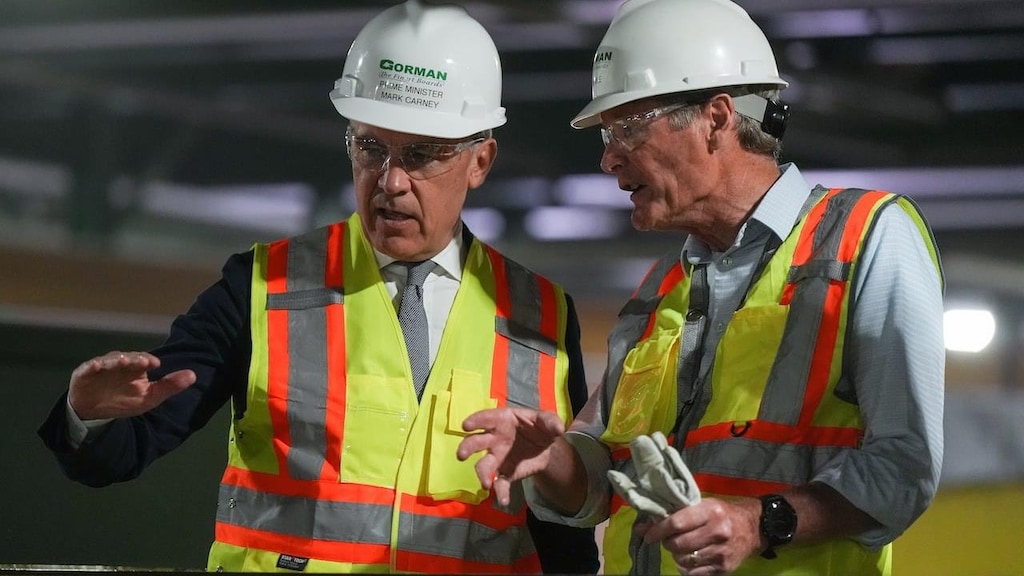In a bold declaration of independence and economic ambition, Canadian Prime Minister Mark Carney unveiled six transformative mega-projects poised to reshape the nation’s economic landscape, sending shockwaves across the border to the United States. This momentous announcement, made in northern British Columbia, signifies a decisive pivot in Canadian strategy, marking the most significant shift since the country’s early days of Confederation.

Carney’s unveiling comes at a critical juncture, as former President Donald Trump has increasingly leveraged tariffs and protectionist policies to assert U.S. dominance over its northern neighbor. However, instead of cowering under pressure, Canada is stepping up, building its future on its terms and showcasing its potential as a global leader in clean energy and critical minerals.
Central to Carney’s vision is the development of new trade and economic corridors aimed at diversifying markets and enhancing Canadian independence. The Northwest Corridor, a key focus of the announcement, is designed to unlock access to critical minerals and facilitate clean power transmission, all while placing Indigenous leadership at the forefront. This initiative encompasses infrastructure improvements, including new transmission lines, upgraded highways, and enhanced communication networks, ultimately positioning Canada as a formidable player in the clean energy sector.

The Prime Minister’s strategy extends beyond mere infrastructure. He introduced a comprehensive clean energy strategy featuring rapid tax incentives, a new productivity super deduction, and a $10 billion commitment from the Canada Infrastructure Bank. Notably, Carney emphasized the pivotal role nuclear energy will play, with plans for small modular reactors and utility-scale nuclear projects becoming integral to Canada’s future energy grid.
One of the standout projects is the Eullet hydro project, marking a historic first as the first fully Inuit-owned hydro development in Canada. This project is expected to eliminate nearly $2 billion in diesel use over the next fifty years while reinforcing Arctic sovereignty amid rising international interest in the region. The symbolism of this initiative resonates deeply, especially against the backdrop of renewed U.S. military focus on the Arctic.
Carney also spotlighted the Northwest Critical Conservation Corridor, a visionary blend of Indigenous-led economic development and significant conservation efforts. This ambitious corridor will enhance access to the Golden Triangle’s mineral deposits and modernize vital infrastructure, all while committing to environmental stewardship on an unprecedented scale.
The announcement comes at a time when the global demand for critical minerals is set to soar. Carney highlighted Canada’s unique position to become a trusted supplier of essential resources, particularly as the U.S. grapples with supply chain instability under Trump’s erratic tariff regime. To expedite this shift, Carney proposed a new sovereign fund dedicated to critical minerals, aiming to fast-track development and ensure Canada remains competitive in the global market.

In a striking counter to Trump’s aggressive trade tactics, which have included sweeping tariffs on Canadian industries, Carney’s initiatives represent a structural counterpunch. Rather than succumbing to pressure, Canada is laying the groundwork for a self-sufficient industrial future, one that does not rely on U.S. approval or support.
The indigenous ownership framework embedded in these projects marks a significant departure from traditional development models, transforming communities into active stakeholders in their economic futures. This contrasts sharply with the often-contentious relationships between federal agencies and tribal nations in the U.S., highlighting Canada’s commitment to partnership and collaboration.
As Canada asserts its industrial identity, the implications of these mega-projects extend far beyond national borders. The Northwest Corridor, if fully realized, will enable Canada to transport minerals and manufactured goods directly to global markets, bypassing U.S. transit routes and challenging the long-held assumption that Canada is economically dependent on the United States.
The urgency of Carney’s announcement reflects a newfound national pride and determination in Canada, signaling a departure from years of reactive policies shaped by U.S. pressures. Instead of merely responding to tariffs and trade disputes, Canada is now proactively crafting its own narrative, one that emphasizes clean energy, Indigenous partnership, and economic resilience.
In summary, Carney’s unveiling of these six mega-projects is more than an infrastructure initiative; it is a powerful statement of Canadian identity and ambition. As the nation charts its course toward a more independent and sustainable future, the question remains: will these projects unfold swiftly enough to secure Canada’s new posit






